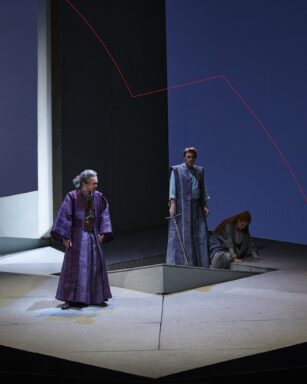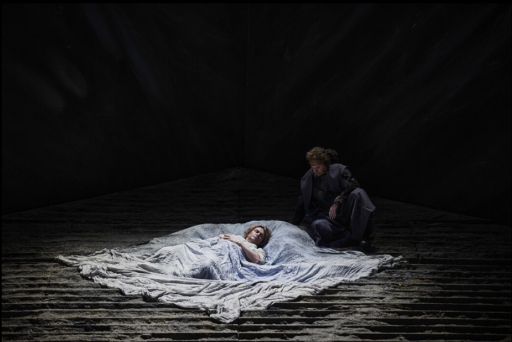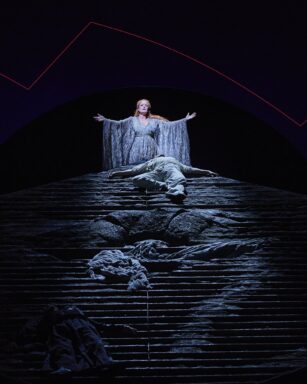Dresden. Semperoper, Season 2023/2024
“TRISTAN UND ISOLDE”
Opera in three acts. Libretto and music by Richard Wagner
Tristan KLAUS FLORIAN VOGT
Isolde CAMILLA NYLUND
Marke, King of Cornwall GEORG ZEPPENFELD
Kurwenal MARTIN GANTNER
Brangäne TANJA ARIANE BAUMGARTNER
Melot SEBASTIAN WARTIG
Ein Hirt ATTILIO GLASER
Ein Steuermann LAWSON ANDERSON
Ein junger Seemann ATTILIO GLASER
Sächsiche Staatskapelle Dresden
Sächsiche Staatsopern Chor Dresden
Conductor Christian Thielemann
Chorus master André Kellinghaus
Staging and Set Design Marco Arturo Marelli
Costume Design Dagmar Niefind-Marelli
Lightdesign Friedewalt Degen
Stage music Alexander Bülow
Co-production with the Opéra de Montpellier
Dresden, 28th January 2024.
The third of four performances of Richard Wagner’s Tristan and Isolde was received in triumph at Dresden’s Semperoper on Sunday 28th January. The production which was first presented almost 30 years ago, remains fresh and ageless and the singers and musicians under the calm mastery of the outgoing musical director Christian Thielemann gave individual and ensemble displays of excellence. The aesthetic and drammaturgical impact of Marco Arturo Marelli’s brilliantly simple and powerful set design cannot be overestimated. The encircling ring of tall panels were used to effect to delimit the world of Tristan and Isolde from an unlimited background space, imaginatively suggesting a ship, a walled garden, and a castle across the three acts.  But it was the large, raised and tilted diamond shaped platform converging towards the conductor the stunning focus. The front point which converged towards the conductor created a strong visual and musical connection, and worked as a galvanizing effect on audience attention. The almost vertical position of the platform in Act lll evoked a steep castle, and cleverly allowed the dying Tristan a close up effect in his death throws and from its highest tip an ecstatic Isolde to soar back into eternity. The appearance in Act ll of sheer curtains dropping from the flies which envelope the platform, isolating Tristan and Isolde and creating an intimate and dreamlike world of their own was a delicate and simply perfect visualization of the couple’s psychological and emotional state. The eloquent staging was enhanced throughout by the skillful and dynamic lighting of Friedwalt Deger, as deeply atmospheric in creating the external and internal worlds as he was in highlighting and illuminating the characters’ emotions; the whole sense of the opera. Dagmar Niefind-Marelli costumes elegantly and discreetly underlined the social status of each role and blended chromatically with the lighting design to
But it was the large, raised and tilted diamond shaped platform converging towards the conductor the stunning focus. The front point which converged towards the conductor created a strong visual and musical connection, and worked as a galvanizing effect on audience attention. The almost vertical position of the platform in Act lll evoked a steep castle, and cleverly allowed the dying Tristan a close up effect in his death throws and from its highest tip an ecstatic Isolde to soar back into eternity. The appearance in Act ll of sheer curtains dropping from the flies which envelope the platform, isolating Tristan and Isolde and creating an intimate and dreamlike world of their own was a delicate and simply perfect visualization of the couple’s psychological and emotional state. The eloquent staging was enhanced throughout by the skillful and dynamic lighting of Friedwalt Deger, as deeply atmospheric in creating the external and internal worlds as he was in highlighting and illuminating the characters’ emotions; the whole sense of the opera. Dagmar Niefind-Marelli costumes elegantly and discreetly underlined the social status of each role and blended chromatically with the lighting design to feature the individual temperaments. In addition to being beautiful and striking in their own right, the costumes appeared as convincing and up to date as they must have been thirty years ago. Apart from the necessary action moments, mainly in Act l and Act lll, and the exits and entrances, there was little stage direction to speak of. The lack of physical reaction produced some unnecessarily stilted moments, the most conspicuous being the lovers’ tryst at the beginning of the second act. Held at a Covid distance, their backs pinned to the wall, Wagner’s stage direction that they embrace passionately was totally ignored. The long ecstatic, passionate duet where they can finally and explicitly express their physical contact looked straight-jacketed and sounded at odds with the tumbling text and the tumultuous orchestration. But these moments were quickly re-absorbed as the audience’s attention was focused
feature the individual temperaments. In addition to being beautiful and striking in their own right, the costumes appeared as convincing and up to date as they must have been thirty years ago. Apart from the necessary action moments, mainly in Act l and Act lll, and the exits and entrances, there was little stage direction to speak of. The lack of physical reaction produced some unnecessarily stilted moments, the most conspicuous being the lovers’ tryst at the beginning of the second act. Held at a Covid distance, their backs pinned to the wall, Wagner’s stage direction that they embrace passionately was totally ignored. The long ecstatic, passionate duet where they can finally and explicitly express their physical contact looked straight-jacketed and sounded at odds with the tumbling text and the tumultuous orchestration. But these moments were quickly re-absorbed as the audience’s attention was focused  elsewhere; and that was at the outstanding vocal and orchestral performances. The audience was treated to splendid cast of world class standing. Klaus Florian Vogt in his debut in the title role was a perfect match to Camilla Nylund’s Isolde. Vogt’s lighter, brighter tenor than is usual in this role could rely on clear diction, a natural sense of phrasing and stamina to convincingly portray restrainment in the first act, youthful passion and enthusiasm in the second and delirium and anguish in the third. The love duet was a superb reciprocal musical interplay of supple and expressive singing with both singers leaning heavily on their innate lyrical quality to express their rapture. Nyland gave generously and her full, round vocality never faltered, in fact it went from strength to strength. Over the course of the three acts she persuasively conveyed the different phases of her love with adroit musicality and artful vocality passing from her first youthful impatience to the calm moving power of her apotheosis at the end of act lll. But the really stunning performance of the evening came from Georg Zeppenfeld as King Marke. Every aspect of his performance was magnetic, beginning with the allure of his rich vibrant vocal colour, gravitas and poise. But equally riveting was the deployment of his perfect diction and articulation, the clarity of his text, the beauty of his phrasing and the meaningful self-awareness of his
elsewhere; and that was at the outstanding vocal and orchestral performances. The audience was treated to splendid cast of world class standing. Klaus Florian Vogt in his debut in the title role was a perfect match to Camilla Nylund’s Isolde. Vogt’s lighter, brighter tenor than is usual in this role could rely on clear diction, a natural sense of phrasing and stamina to convincingly portray restrainment in the first act, youthful passion and enthusiasm in the second and delirium and anguish in the third. The love duet was a superb reciprocal musical interplay of supple and expressive singing with both singers leaning heavily on their innate lyrical quality to express their rapture. Nyland gave generously and her full, round vocality never faltered, in fact it went from strength to strength. Over the course of the three acts she persuasively conveyed the different phases of her love with adroit musicality and artful vocality passing from her first youthful impatience to the calm moving power of her apotheosis at the end of act lll. But the really stunning performance of the evening came from Georg Zeppenfeld as King Marke. Every aspect of his performance was magnetic, beginning with the allure of his rich vibrant vocal colour, gravitas and poise. But equally riveting was the deployment of his perfect diction and articulation, the clarity of his text, the beauty of his phrasing and the meaningful self-awareness of his delivery to maintain interest and elicit empathy. He exuded sorrow, pain, hurt, betrayal, and disappointment, simultaneously with nobility, authority and humanity. The remaining cast members were a delight. Sebastian Wartig was an incisive and significant vocal and stage presence as Melot, Martin Gantner a robust and earthy companion to Tristan as Kurnewal, Tanja Ariane Baumgartner, substituting an indisposed Christa Mayer, an enchanting Brangäne, and Lawson Anderson a fine steersman. But absolutely captivating was the luxury casting of Attilio Glaser in the double role as a shepherd and a seaman. He sang the soaring, unaccompanied folk melodies with tenderness and melancholy leaving behind a wake of wistfulness and longing. A beautifully musical performance. But even with these superb portrayals, at the heart of the performance was a peerless Thielemann the distinguished Wagnerian. His gestures were circumspect and contained but nevertheless alert and consequential; his manner was essential, concentrated and
delivery to maintain interest and elicit empathy. He exuded sorrow, pain, hurt, betrayal, and disappointment, simultaneously with nobility, authority and humanity. The remaining cast members were a delight. Sebastian Wartig was an incisive and significant vocal and stage presence as Melot, Martin Gantner a robust and earthy companion to Tristan as Kurnewal, Tanja Ariane Baumgartner, substituting an indisposed Christa Mayer, an enchanting Brangäne, and Lawson Anderson a fine steersman. But absolutely captivating was the luxury casting of Attilio Glaser in the double role as a shepherd and a seaman. He sang the soaring, unaccompanied folk melodies with tenderness and melancholy leaving behind a wake of wistfulness and longing. A beautifully musical performance. But even with these superb portrayals, at the heart of the performance was a peerless Thielemann the distinguished Wagnerian. His gestures were circumspect and contained but nevertheless alert and consequential; his manner was essential, concentrated and  unflamboyant without foresaking depth and emotion ; a synthesis of his own Tristan and Isolde experience. From the opening notes his execution flowed seamlessly allowing the salient musical features to emerge without ever resorting to emphasis. He didn’t wallow in the opening Tristan accord but neither did he rush. He did however keep the tempo moving until the end. There was no hint of self-indulgence. The ensemble rapport conductor, singer, orchestra exuded confidence, ease and trust. Thielemann kept perfect control of the proceedings, only unleashing the orchestra when their combined force didn’t risk coming into direct competition with the voices. For it’s part, the orchestra played impeccably both technically and musically, totally engaged until the end. Such a visual and aural pleasure to see the sweep of a line of
unflamboyant without foresaking depth and emotion ; a synthesis of his own Tristan and Isolde experience. From the opening notes his execution flowed seamlessly allowing the salient musical features to emerge without ever resorting to emphasis. He didn’t wallow in the opening Tristan accord but neither did he rush. He did however keep the tempo moving until the end. There was no hint of self-indulgence. The ensemble rapport conductor, singer, orchestra exuded confidence, ease and trust. Thielemann kept perfect control of the proceedings, only unleashing the orchestra when their combined force didn’t risk coming into direct competition with the voices. For it’s part, the orchestra played impeccably both technically and musically, totally engaged until the end. Such a visual and aural pleasure to see the sweep of a line of the double bass bows perfectly synchronized and be drawn into their deep vibrant resonance, to cite just one instant out of plethora of significant orchestral moments. The wind and brass solos were remarkable for their understated presence in the context of the orchestral weft. Thielemann tirelessly held the threads together and ensured that at no moment was a performer overpowered; the harp was as audible as the trombones and horns, and Tristan and Isolde could be permitted a murmur. But the bottom line was, that the performance stood as more than the sum of its parts. Thielemann aided by first class performers and collaborators had accomplished a powerful and deeply moving experience, enthusiastically acknowledged at the numerous curtain calls. Photo Ludwig Olah
the double bass bows perfectly synchronized and be drawn into their deep vibrant resonance, to cite just one instant out of plethora of significant orchestral moments. The wind and brass solos were remarkable for their understated presence in the context of the orchestral weft. Thielemann tirelessly held the threads together and ensured that at no moment was a performer overpowered; the harp was as audible as the trombones and horns, and Tristan and Isolde could be permitted a murmur. But the bottom line was, that the performance stood as more than the sum of its parts. Thielemann aided by first class performers and collaborators had accomplished a powerful and deeply moving experience, enthusiastically acknowledged at the numerous curtain calls. Photo Ludwig Olah
